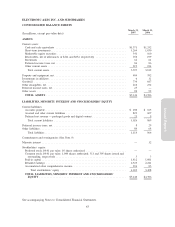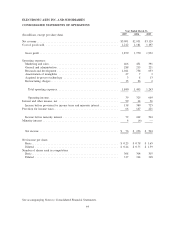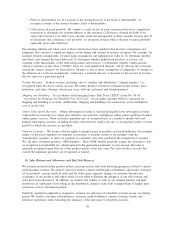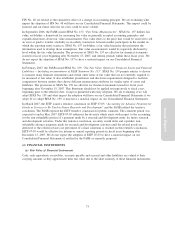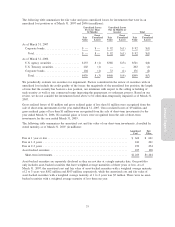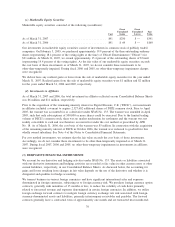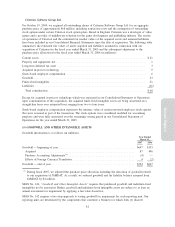Electronic Arts 2007 Annual Report Download - page 146
Download and view the complete annual report
Please find page 146 of the 2007 Electronic Arts annual report below. You can navigate through the pages in the report by either clicking on the pages listed below, or by using the keyword search tool below to find specific information within the annual report.(p) Foreign Currency Translation
For each of our foreign operating subsidiaries, the functional currency is generally its local currency. Assets
and liabilities of foreign operations are translated into U.S. dollars using month-end exchange rates, and
revenue and expenses are translated into U.S. dollars using average exchange rates. The effects of foreign
currency translation adjustments are included as a component of accumulated other comprehensive income in
stockholders’ equity.
Foreign currency transaction gains and losses are a result of the effect of exchange rate changes on
transactions denominated in currencies other than the functional currency. Foreign currency transaction gains
(losses) of $10 million, $(1) million and $25 million for the fiscal years ended March 31, 2007, 2006 and
2005, respectively, are included in interest and other income, net, in our Consolidated Statements of
Operations.
(q) Impact of Recently Issued Accounting Standards
In February 2006, the Financial Accounting Standards Board (“FASB”) issued SFAS No. 155, “Accounting for
Certain Hybrid Financial Instruments — An Amendment of FASB Statements No. 133 and 140”. SFAS No. 155
(1) permits fair value measurement for any hybrid financial instrument that contains an embedded derivative
that otherwise would require bifurcation, (2) clarifies that interest-only strips and principal-only strips are not
subject to the requirements of SFAS No. 133, “Accounting for Derivative Instruments and Hedging Activities”,
(3) establishes a requirement to evaluate interests in securitized financial assets to identify interests that are
freestanding derivatives or that are hybrid financial instruments that contain an embedded derivative requiring
bifurcation, (4) clarifies that concentrations of credit risk in the form of subordination are not embedded
derivatives, and (5) amends SFAS No. 140, “Accounting for Transfers and Servicing of Financial Assets and
Extinguishments of Liabilities — A Replacement of FASB Statement No. 125” to eliminate the prohibition on a
qualifying special-purpose entity from holding a derivative financial instrument that pertains to a beneficial
interest other than another derivative financial instrument. In December 2006, the FASB cleared guidance in
Derivatives Implementation Group Statement 133 Implementation Issue No. B40, “Embedded Derivatives:
Application of Paragraph 13(b) to Securitized Interests in Prepayable Financial Assets”. FASB concluded that
a securitized interest in prepayable financial assets is not subject to the conditions in paragraph 13(b) of
SFAS No. 133 if it meets the two criteria outlined in the Statement 133 Implementation Issue No. B40.
SFAS No. 155 is effective for all financial instruments acquired or issued for fiscal years beginning after
September 15, 2006. The guidance in the Statement 133 Implementation Issue No. B40 is applicable upon
adoption of SFAS No. 155, although the FASB provides certain exceptions as described in the Statement 133
Implementation Issue No. B40. We do not expect the adoption of SFAS No. 155 or Statement 133
Implementation Issue No. B40 to have a material impact on our Consolidated Financial Statements.
In July 2006, the FASB issued FASB Interpretation (“FIN”) No. 48, “Accounting for Uncertainty in Income
Taxes — An Interpretation of FASB Statement No. 109”. FIN No. 48 clarifies the accounting for uncertainty in
income taxes recognized in financial statements in accordance with SFAS No. 109, “Accounting for Income
Taxes”. FIN No. 48 prescribes a recognition threshold and measurement attribute for the financial statement
recognition and measurement of a tax position taken or expected to be taken in a tax return and provides
guidance on derecognition, classification, interest and penalties, accounting in interim periods, disclosure, and
transition. Under FIN No. 48, the evaluation of a tax position is a two-step process. The first step is a
recognition process where we are required to determine whether it is more likely than not that a tax position
will be sustained upon examination, including resolution of any related appeals or litigation processes, based
on the technical merits of the position. In evaluating whether a tax position has met the more-likely-than-not
recognition threshold, it is presumed that the position will be examined by the appropriate taxing authority
that has full knowledge of all relevant information. The second step is a measurement process whereby a tax
position that meets the more-likely-than-not recognition threshold is calculated to determine the amount of
benefit to recognize in the financial statements. FIN No. 48 also requires new tabular reconciliation of the
total amounts of unrecognized tax benefits at the beginning and end of the reporting period. The provisions of
FIN No. 48 are effective for fiscal years beginning after December 15, 2006. As such, we are required to
adopt it in our first quarter of fiscal year 2008. Any changes to our income taxes due to the adoption of
72



